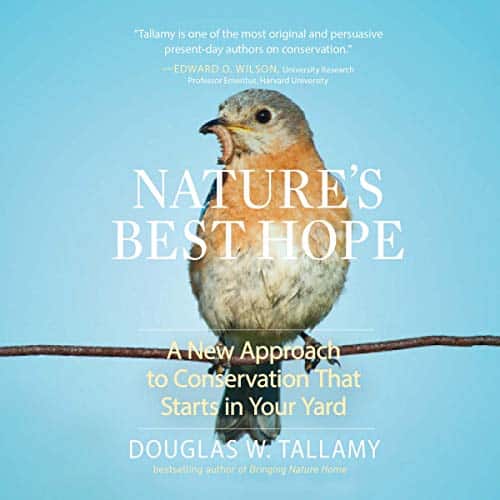In his new book entitled Nature’s Best Hope, Dr. Doug Tallamy introduces an inspiring vision for creating a “Homegrown National Park” system. His vision involves yards that serve as conservation corridors to support local wildlife and migrating bird populations. The steps he recommends aren’t difficult. In fact, for most of us, it involves a few more plants, a few simple changes to our gardening routines, and a few inexpensive tweaks. Get started by reading over this list and book-marking this page for future reference.
1. Plant Super-Native Plants and Trees
Super-native plants feed a large variety of insects and birds. Be sure to include goldenrod, asters, perennial sunflowers, and native willow. Learn more about super-natives in this article.
2. Develop Caterpillar Micro-Habitats
Micro-habitats can be developed under native trees by planting native plants, maintaining loose soil, and leaving leaf litter. Mulch around native plant beds with leaf litter. Some caterpillars tunnel into soft wood to pupate, so add some decaying logs to your micro-habitats.
3. Eliminate Unnecessary Night Lighting
This type of lighting kills moths and other insects. If you can’t eliminate the lighting, add a motion sensor to the fixture. Learn more by reading this article.
4. Help Restore Native Bee Populations
You can help to restore native bee populations by providing shelter, nest sites, and food. Learn more here.
5. Shrink Your Lawn
Try to replace half of your lawn with native plants. Think of your lawn as an area rug, not a wall-to-wall carpet.
6. Remove Invasive Species
Common examples of invasive species are Callery pear trees and bush honeysuckles. For more info on invasive plant species, read this article.
7. Install Inexpensive Window Well Covers
Window well covers help to prevent the deaths of toads, frogs, and other small creatures who become trapped inside and starve.
8. Try Not to Mow in the Evening
As dusk approaches, many nocturnal species leave their hiding places and are vulnerable to a mower blade or wheel.
9. Install One or More Water Sources
Try to add water sources to your yard, and include a solar bubbler. Bird watchers report that one of the best way to increase birds in your yard is to provide water. You can learn how here.
10. Garden Organically
Don’t use fertilizer or pesticide in your garden. Leave natural leaf litter as mulch and add other organic matter to enhance the soil. (You can add your own organic matter by composting). Oppose mindless mosquito spraying that kills ALL insects. Mosquitoes are best controlled in the larval stage. This is easy to do with a bucket of water.
11. Leave Your Garden a Little “Wilder”
Keep a messier in the fall and winter and delay clean-up until the Spring. Leave dried stems and pieces of dead wood around the garden to support native bee populations.
12. Provide Dead Wood Shelter in Your Garden
If you have an unobtrusive location, add a brush pile to provide cover for birds and butterflies. If you can do so safely, keep dead trees as snags.
13. Keep Your Cat Inside
Most people do not understand the full extent to which cats kill wildlife. The simplest way to mitigate this is to keep your cats inside. If you’re unwilling to do that, outfit your cat with one of these wildlife-saving cat collars.
14. Install Bird Feeders in Clearings
Birds at feeders are extra-vulnerable to a neighborhood cat, especially if there are shrubs or other vegetation nearby. Keep shrubs and taller vegetation 10′ away from bird feeders.
15. Prevent Bird Strikes
Learn about the problem of birds hitting windows to make your property safer for birds. Make sure you have window coverings on all your windows, turn off interior lights when not in use, and add window stickers, or try this trick with a glass pen!
Now Share the Message!
Send a page link to your neighbors and friends, or use social media and Nextdoor. You can also educate your neighborhood or homeowner’s association about landscaping for wildlife.




